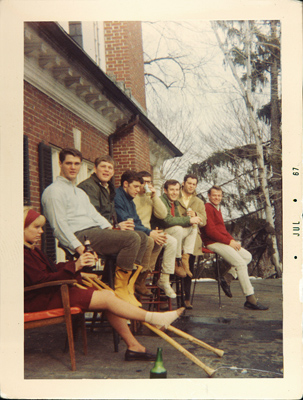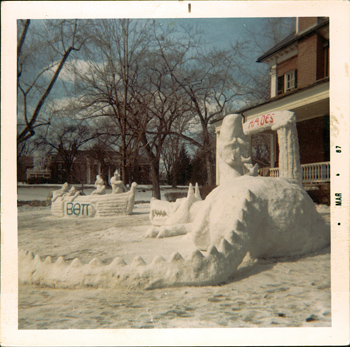By George Fleming ’67 and John Fitchen ’67
[Fun] The Amherst Student billed it as the “first winter weekend in recent years,” although none of us had heard of it personally or from friends in earlier classes. It was named the “Bacchanalia”—alcohol-charged and, by today’s standards, politically incorrect.
But this was 1967, and the event included a snow-sculpture contest whose first prize was two half-kegs of beer. That attracted the attention of the Betas, a fun-loving band of fraternal brothers who were customarily on the margins of everything—but who were soon to be front and center in the college-wide contest.

A week in advance, a handful of Beta Theta Pi brothers developed a theme—and, more surprisingly, a plan—to build a sculpture that would make a statement. A preliminary sketch, now lost in the shadows of time, laid out the design. It would include a boat with passengers, a portal and Cerberus, the mythical three-headed dog that guards the gates to Hades. A squad of scroungers was deployed to procure the necessary materials, and what began as the effort of a handful of shivering visionaries gained momentum as the week wore on.
Progress was slow at first, amounting to little more than the accumulation of three amorphous mounds of snow. But gradually, as the concept emerged and the image sharpened, the labor took on a new urgency, and by Thursday an around-the-clock effort involving nearly every brother was in full swing. Betas showed up on the side lawn of the house (now Garman House) prepared for the chilblains of working bare-handed in the cold. Classwork, even among the dedicated pre-meds, took a backseat. Some brothers built wooden frames to support the gate and the heads and necks of the massive dog. Others acquired lumber from whatever sources were “available.” Hitherto unknown artistic talents appeared out of nowhere as new design elements were added. (In the process of putting this article together, we contacted dozens of former brothers, and no one could recall who provided the artistic vision for the sculpture. It seemed to be a mystical work of art created by the collective wisdom of the brotherhood.)
Endless hours of shoveling, packing and spraying with a garden hose produced a display worthy of Fine Arts 101. Playing upon the Betas’ bad-boy reputation as campus reprobates, the only classics major in the house provided a last-minute title, “Facilis Descensus Averno” (“The Descent to Hell is Easy”).

The sculpture was the runaway winner of the contest and the two half-kegs of Russell’s Package Store’s finest. Instantly, hours of soaked shoes and frozen hands were forgotten.
Beta faculty adviser (and later college president) Bill Ward, clearly relieved that Beta had actually done something worthwhile, observed that the oeuvre was simultaneously poignant, ironic, compelling and self-deprecating. He sent the fraternity an additional keg with a note that read, “To the best and brightest on campus.” The brothers gathered on the porch roof on the south side of the house and watched the parade of admiring gawkers driving by on Route 9, many of them just missing being rear-ended. The three kegs were consumed forthwith. And the Bacchanalia made its lasting imprint on the otherwise dreary March of 1967.
Fleming is managing principal of a leadership and career coaching business. Fitchen is professor emeritus of medicine at Oregon Health Sciences University.